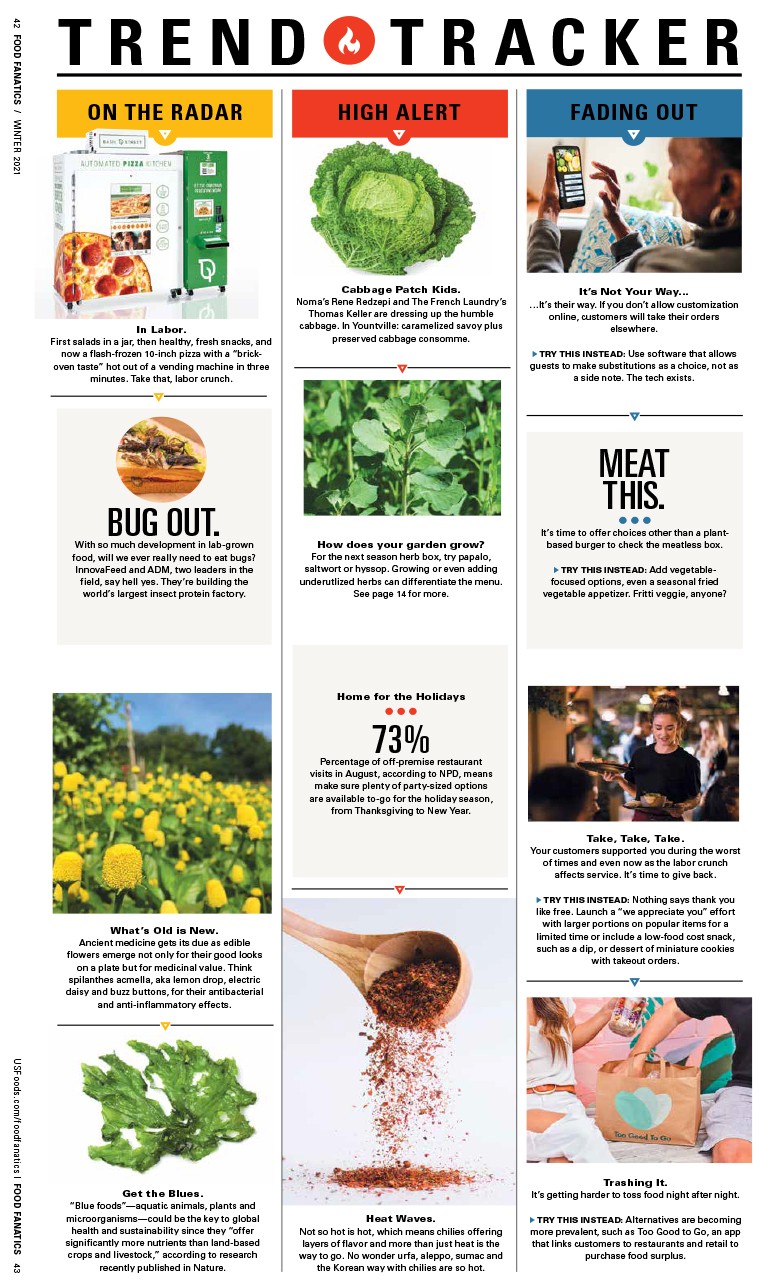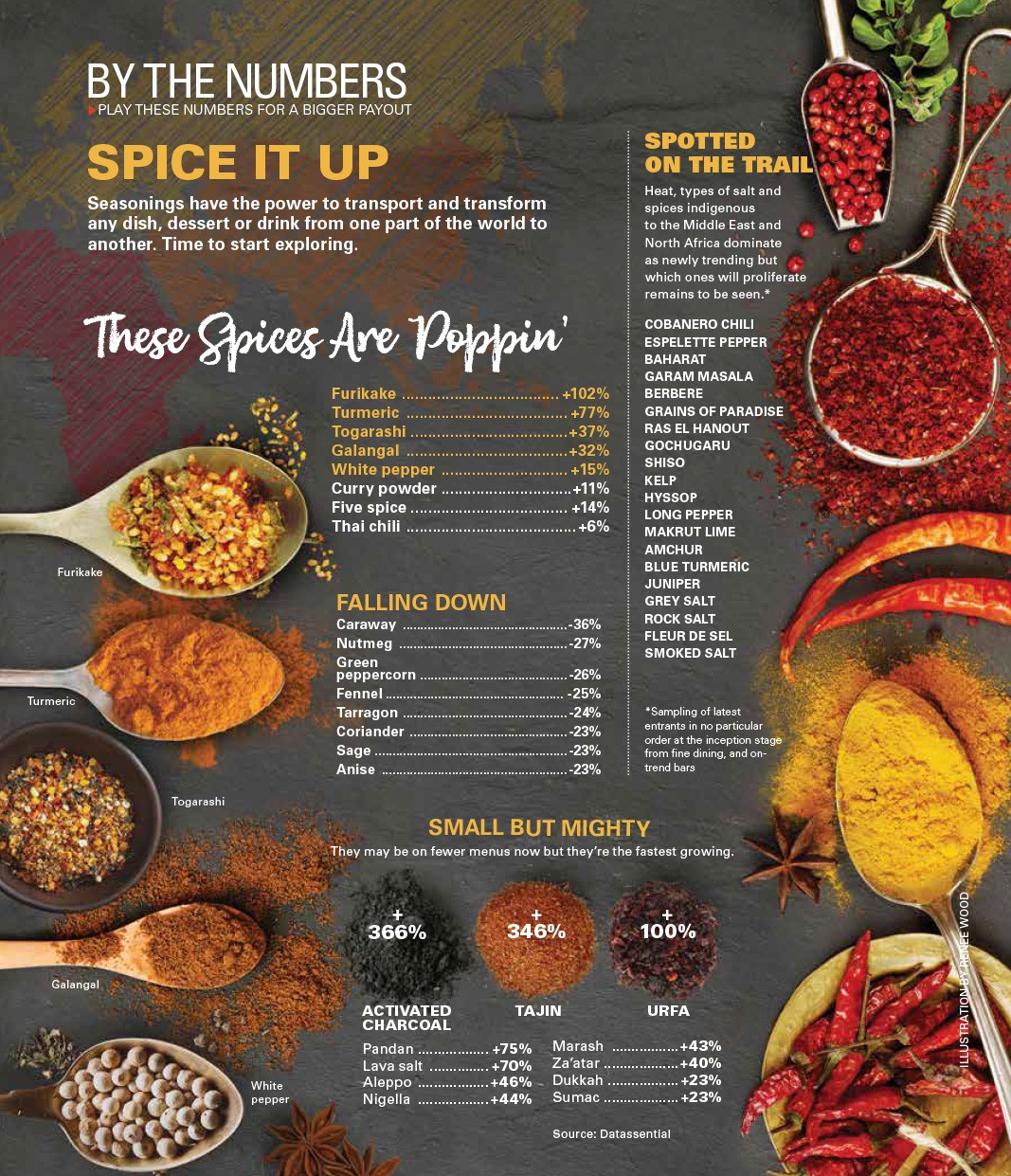TYPES OF DUMPLINGS FROM ACROSS THE GLOBE
Every culture has a sweet spot for stuffed packages
There’s a reason the word “dumpling” is a term of endearment. Be it pierogies, samosas, ravioli or xiao long bao, it’s difficult to find anyone who doesn’t have childhood memories of stuffed pasta. For chefs, that means tapping into their guests’ innate sense of nostalgia.
“If you have dumplings, it’s intuitive because it’s dough with stuff in the middle. Every culture on the planet has their version of that,” says Chef-owner Bonnie Morales, who serves traditional pelmeni and vareniki at her Russian-inspired restaurant, Kachka, in Portland, Oregon.
From dim sum carts to food trucks, fast casual or fine dining, there are no limits to what can be wrapped into a little pocket.
DIFFERENT DUMPLINGS AROUND THE WORLDJiaozi [China] Pleated, flat-bottomed crescent; steamed, boiled, pan-fried; stuffed with ground meat and minced vegetables. Mandu [Korea] Crescent-shaped; boiled, steamed or pan-fried; stuffed with minced meat, kimchi, tofu, glass noodles, ginger and green onions. Momo [Nepal] Pleated pouches or crescents; steamed; stuffed with minced meat, paneer and potatoes. Pelmeni [Russia] Hexagonal-shaped; boiled or steamed; stuffed with minced meat, beef, veal pork, or a mixture of fish and mushrooms. Pierogi [Poland] Crescent-shaped; boiled or pan-fried; stuffed with potato and cheese, sauerkraut and fruit. Ravioli [Italy] Square; boiled; stuffed with meat, cheese, spinach and shellfish. Samosa [India] Pyramid-shaped; fried; stuffed with potatoes, legumes, beef and lamb. Shui Jiao [China] Pleated crescent; boiled; stuffed with ingredients like pork and chives or shrimp, mushrooms and cabbage. Tortellini [Italy] Navel-shaped; boiled; stuffed with a variety of fillings such as prosciutto, veal, chicken, pork or cheese. Vareniki [Ukraine] Crescent-shaped; boiled or steamed; stuffed with farmer’s cheese, potato and fruit. Xiao Long Bao [China] Bite-sized pleated dumpling, stuffed and steamed with meat and aspic. |
The People Speak
In 2007, Helen You, a native of Tianjin in northeastern China, opened a small dumpling stand in a subterranean food court in Flushing, New York. Equipped with hardly more than what she learned from her mother and grandparents, You started with three varieties. Today, her second restaurant, Dumpling Galaxy, makes up to 12,000 dumplings a day to-order in 98 varieties.
The secret to her success? Listening to her guests. “I communicate with my customers (and) customize dumpling ingredients,” she says. “More and more came through word of mouth.”
Combinations like Sichuan peppercorn-seasoned lamb with green squash, dried octopus and chives, and asparagus and egg fill a choice of wrappers, such as rice flour, cornmeal and whole wheat.
The most popular variety is shui jiao, or boiled dumplings. Each one delivers a burst of hot, savory soup. “They’re juicy, but not greasy,” she says.
REIMAGINING TRADITIONAL DUMPLING FILLING
It’s possible to tweak tradition for modern tastes and still maintain credibility with purists. Traditional beef, veal and pork pelmeni and farmer’s cheese vareniki are gateway bites for introducing guests to Russian- and Ukrainian-inspired food at Kachka. Since opening, fillings have expanded to specials like brandade or lamb with Georgian spiced pepper paste.
“You don’t usually see lamb pelmeni or salt cod vareniki,” says Morales, who boils and serves more than 2,600 dumplings per service. “But the flavor profiles are still in our wheelhouse.”
DUMPLING FUSION – BLENDING CUISINES
Nearly 11 percent of fast casual restaurants offer some form of a dumpling, according to foodservice research firm Datassential. They’re also popping up in full-service and fine dining settings.
“You can put anything in a dumpling,” says Chef Cara Stadler, who offers 10 Chinese-style dumplings along with Asian-inspired craft cocktails at Bao Bao Dumpling House in Portland, Maine. Stadler, who ran an underground supper club with her mother in Beijing, mixes traditional fillings like pork and cabbage with more unconventional varieties, like beef and yellow curry, and her top-selling Kung Pao chicken.
A dumpling can find a home in any concept. Asian, European and African traditions collide at The Cecil in New York, where Chef de Cuisine Joseph “JJ” Johnson brings together influences from three countries with his take on oxtail dumplings paired with green apple curry and a crispy taro chip.
“These dumplings are inspired by my study of the African diaspora,” he says. “Africans landed in regions all over the world that featured different local foods, cuisines and cooking styles. The oxtail represents the Caribbean, the curry from India and the dumpling wrapper from China.”
Johnson braises oxtails in pink peppercorns, coriander seeds and cinnamon sticks, then shreds the meat and portions it into one-ounce servings wrapped in wontons. Steamed, the dumplings are served in a sauce of green apples braised in a light coconut curry.
THE ART OF DUMPLING ASSEMBLY & PREP
While dumpling food costs can be extraordinarily low, they often require a lot of labor to achieve consistency. Making head cheese pierogies is a three-day process for Chef Josh Stockton of Detroit’s Gold Cash Gold, but the freezer stretches the shelf life of his stash. Most of the process is low maintenance, but stuffing them takes three to four people roughly 2 to 3 hours to create 400.
That labor is offset by low product cost, using parts from a whole hog that he picks up from his father’s farm every two weeks. First, he brines the head and trotters for three days, before braising in chicken stock. Then, he seasons the shredded meat with sherry vinegar, shallots, parsley, tarragon and just enough braising liquid to keep it moist. At service, they’re blanched, dried off, browned in butter and served three to a plate with house-made sauerkraut and creme fraiche for $13.
Working ahead is essential for the Chirba Chirba Dumpling Truck in Durham, North Carolina, which churns out 6,000 dumplings per week. Nate Adams, head of operations, says he and his partners didn’t anticipate the demand when they started rolling four years ago.
“We immediately ran into a problem of scaling,” he says of their former method, which involved stuffing dumplings all night after long days in the streets. All hands on deck can bang out a lot of dumplings in a short amount of time, using an assembly line to prep and freeze batches in a commissary kitchen.
"You can put anything in a dumpling."
-Chef Cara Stadler of Bao Bao Dumpling House, Portland, Maine
FUTURE DUMPLING FILLINGS
Some chefs are upending ideas about what traditional dumplings are supposed to be. Chef Mike Sheerin of Chicago's soon-to-open counter-service Packed: Dumplings Reimagined is taking traditional Chinese soup dumplings to a new level with fillings like posole, French onion, and butternut squash and caramelized scallops. For his vegan guests, he's making a puréed asparagus and oil emulsion with charred asparagus tips, stabilizing it with agar-agar, freezing it, and wrapping it in a classic, 17-fold soup dumpling.
"It's a super hard dumpling to make because I've got fat fingers," he says. It's a problem he's resolved with practice, making test batches every day for months before opening. You need to have some ventilation so the steam escapes and it doesn't blow up," Sheerin says.
In Los Angeles, Alimento Chef-owner Zach Pollack inverts the classic northern Italian meat-filled dumpling soup, tortellini en brodo. Putting the soup on the inside turned out to be an original inspiration that has made the dish a top seller since day one.
He starts with a collagen-rich aspic of beef, chicken and prosciutto hocks with finely ground mortadella, nutmeg and white pepper. The filling meets traditional pasta dough, which is folded into oversized navel-shaped tortellini. They’re served in a sauce of pasta water mounted with butter and prosciutto.
His tortellini in brodo “al contrario” are “large enough that you can get the explosion of liquid, but it’s not so big that you can’t eat it in one bite.” And that’s a novel dumpling experience anyone can appreciate.
Mike Sula is a James Beard award-winning food writer for the Chicago Reader. Follow him on Twitter @MikeSula.



